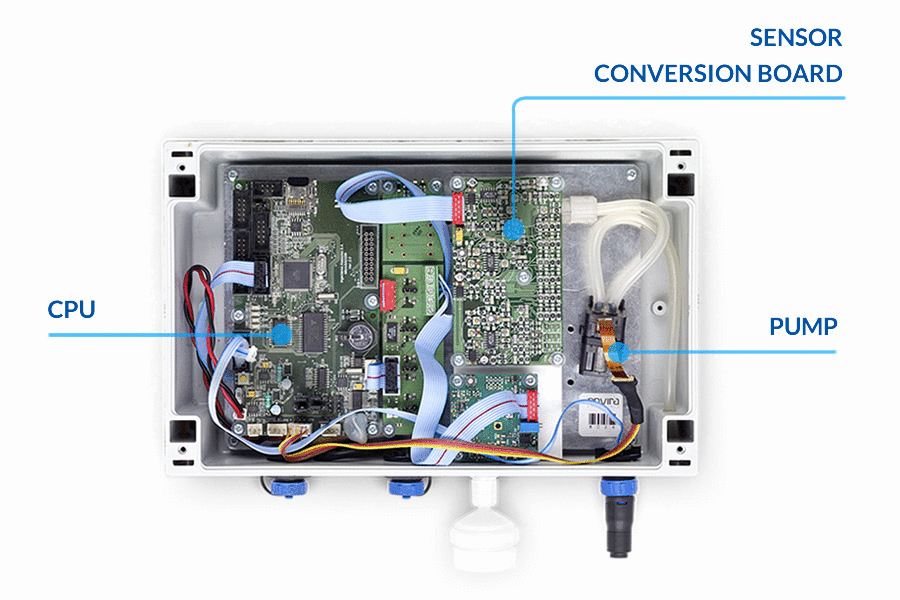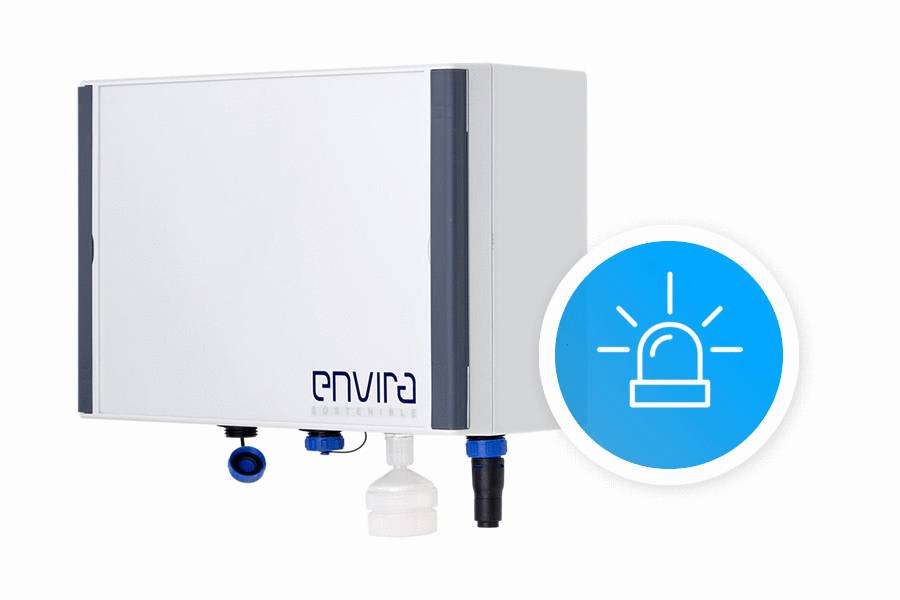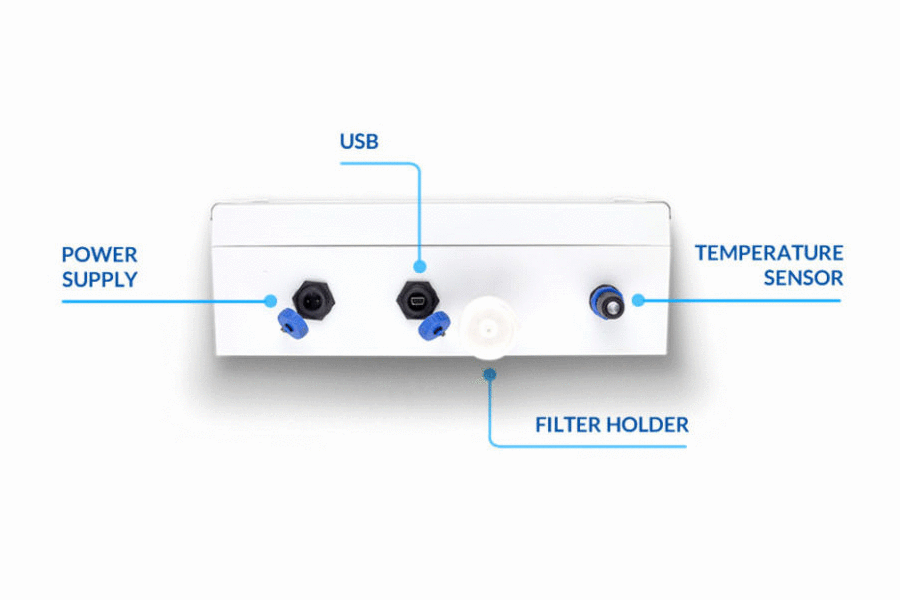
The negative effects of poor air quality in indoor spaces affect many people, as it has been proved that city inhabitants spend a 60-80% of their time indoors, in places that are more or less polluted.
Thanks to Nanoenvi® IAQ technology, wireless networks can be created indoors to transmit real-time information about breathing air to apps that the user can see from a computer, mobile phone or tablet. This helps decide when it is necessary to renew the air and ensure the quality of breathing air. Nanoenvi® IAQ brings high reliability air quality sensors for professional applications. Nanoenvi® IAQ has been designed for working centres, classrooms, hospitals, conference rooms, garages, labs, cinemas, theatres, etc.; that is, any indoor area for public attendance.
With a compact and modern design, the Nanoenvi IAQ device can be easily installed in any room, whether in a tabletop or wall configuration, going completely unnoticed.
The matrix of points that indicates the concentration of pollutants (CO2, CO, VOC, PM10 and PM2.5) stands out in its design, which allows, a simple view, to identify the indoor air quality of the room in which it is located.
Its modular electronics allow the integration of up to 5 sensors to choose from from a list of several dozen: from the usual temperature and humidity sensors to more advanced hydrocarbon sensors (VOCs).
Regardless of their type, all the sensors installed in the Nanoenvi IAQ product are carefully prepared, one by one, in our calibration laboratory, thus achieving the precision, reliability and stability in the measurements required by the reliable detection of the concentrations of contaminants that they can be significant for people’s health and well-being.
Through standard protocols (Lonworks, KNX) Nanoenvi IAQ is able to interoperate with home automation systems provided by third parties. Nanoenvi IAQ equipment can be integrated into any IOT network through the usual M2M protocols: WiFi, 3G, Bluetooth, ZigBee, etc. Like all Nanoenvi devices, IAQ sensors comply with ENVIRA’s Plug’n Play policy, implementing “out of the box” connectors for integration with the IoT platform (both public and proprietary) selected by the client.
Temperature
ANSI/ASHRAE Standard 55 is the American Standard that establishes the ranges of environmental conditions to achieve the optimal thermal comfort inside buildings. The Standard is assessed by subjective evaluation and defines the best indoor temperature for user satisfaction ranges between 20 to 22ºC (68 to 72 ºF).
Pressure
Barometric pressure affects to dew point and water condensation and is also related to the air flows causing bacteria, dust and other airborne pollutants. If air pressure in the room is lower than outside, contamination from the room does not flow out into surrounding areas. Otherwise, higher pressure inside a room, will keep out pollutants.
Humidity
A high relative humidity decreases sweating effectiveness in its body temperature control function, so more sweat is produced is temperature goes high, generating discomfort and sultriness. A low relative humidity cause dryness and itching. Optimal comfort is achieved with a relative humidity in the 30-60% range.
CO
Carbon Monoxide is a silent killer. It cannot be sawn or smelled. CO are in the air whenever fuel or other carbon-based materials are bunt. CO can cause dizziness, headaches, vomits and finally death. Event at low levels, long term exposition to CO can cause chronical hearth diseases and/or EPOC. New-borns, infants, pregnant women, elderly and people affected with respiratory diseases are the top-risk profiles. Vehicles, gas stoves, barbecues, generators and poorly maintained ventilation equipment are the most common CO sources at indoor locations.
CO2
CO2 Breathing becomes more difficult as carbon dioxide levels rise, causing tiredness and making harder to get focused. Rest and sleep quality are also affected by CO2. In closed areas, high levels of carbon dioxide can lead to health complaints such as headaches.
VOC
Volatile Organic Compounds (VOCs) are usual components in many building materials such as plywood, glues, paintings and personal care products (perfume, hair-sprays, lacquer, burnishes, etc.). Other VOC sources are burning gases, wood or tobacco. Exposure to VOCs can cause eye, nose and throat irritation, shortness of breath, headaches, fatigue, nausea, dizziness and skin problems. Higher concentrations may cause irritation of the lungs, as well as damage to the liver, kidney, or central nervous system. Long-term exposure may also cause damage to the liver, kidneys or central nervous system. People affected with asthma are more exposed to VOCs effects.
PM2.5
PM2.5 (particles less than 2.5 micrometers in diameter) can penetrate deeply into the lung, irritate and corrode the alveolar wall, and consequently impair lung function. PM2.5 may therefore be capable of carrying various toxic stuffs, passing through the filtration of nose hair, reaching the end of the respiratory tract with airflow and accumulate there by diffusion, damaging other parts of the body through air exchange in the lungs. The elderly and those with pre-existing cardiopulmonary problems are more exposed to PM2.5 effects.
PM10
Exposure to high concentrations of PM10 can result in health impacts ranging from coughing and wheezing to asthma attacks and bronchitis to high blood pressure, heart attack, strokes and premature death. The young and old and persons with existing medical conditions are most likely to be adversely affected by exposure to high PM10 concentrations.
Nanoenvi IAQ calculates an index of ambient air quality that measures the level of health and well-being in indoor spaces. Users will be able to know the quality of the air they breathe through color codes.
The possible values of the index move in the range 0-7, where:
- 7 optimum quality (blue LEDs).
- 4-6 good quality (green LEDs).
- 2-3 moderate quality (yellow LEDs).
- 0-1 poor quality (red LEDs).

There are two connectivity options for Nanoenvi IAQ devices: WiFi or LoRa. Both options are designed for easy installation and configuration while providing end users with open APIs to integrate IAQ devices into 3rd party platforms and applications.
Remember that, due to our #CloudFree politics, APIs are ever provided at device level, so your applications interoperate directly with Nanoenvi IAQ devices, without a mandatory cloud proxy. Of course, cloud APIs are also available…if you decide to go up to the clouds.

WiFi – Communications
Nanoenvi IAQ – WiFi can be connected to 802.11 WiFi networks through any conventional 2.4GHz WiFi Router.
At application level, IAQ WiFi devices, are fully interoperable through MQTT protocol. For more information about WiFi version interoperability, check the Nanoenvi IAQ – MQTT Interoperability Manual.

LoRaWAN - Communications (SOLD OUT)
Nanoenvi IAQ – LoRA can be connected to LoRa LPWAN networks (EU and US versions available) using LoRaWAN protocol.
At application level, IAQ LoRa devices, use a proprietary protocol based on LoRaWAN. For more information about LoRa version interoperability, check the Nanoenvi IAQ – LoRaWan Interoperability Manual.










SENSORS
Carbon Monoxide (CO)
Volatile Organic Compounds (VOC)
Particulate Matter (PM1.5, PM2.5, PM4, PM10)
Carbon Dioxide (CO2)
Temperature
Humidity
Barometric Pressure
INTERNAL STORAGE
MEMORY CAPACITY IN TERMS OF NUMBER OF MEASUREMENTS
COMMUNICATIONS
WiFi
LoRaWan
POWER
Tension
Maximum Current
DATA PROTOCOLS
MQTT
Device Configuration Using HTTP
Download OTA Updates Via HTTP
±10ppm error
0-60.000 ppb
4 KB0-100 μg/m3 (±10 μg/m3), 100 – 1.000 (±10 %)
0-40.000 ppm (±30ppm + 3%MV)
-40ºC – 70ºC,±(0.4 C + 0.023 × (T C] 25 C))
0 – 100%, ±3 %
50 to 115 kPa, ±1 kPa accuracy
100-240V AC @ 50-60 Hz
0,18 A

Nanoenvi® IAQ
Mobile Wifi Configuration
PC Configuration
Reset Tutorial








